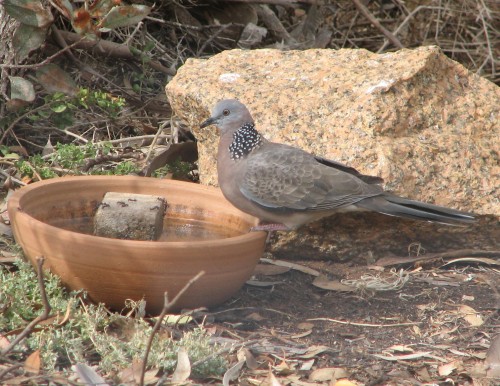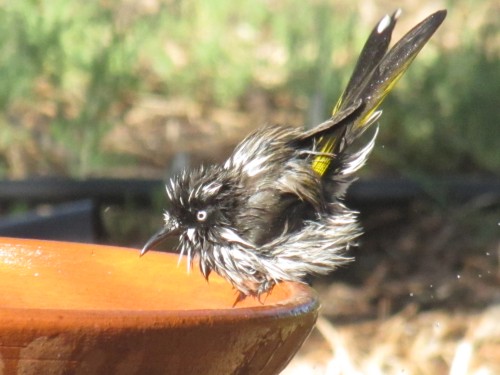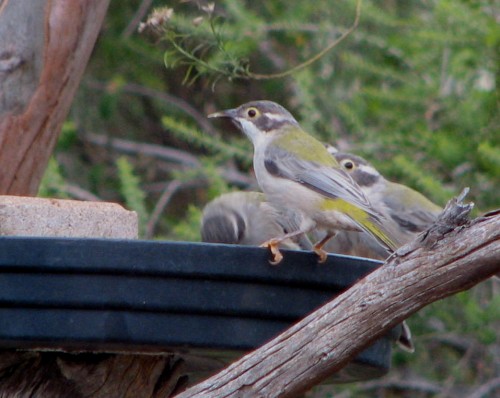The importance of water to birds
I love getting comments from my readers. Every now and then I get a really interesting one, like the one from Sue which I have quoted below.
Happy new year Trevor!
A Big thank you for maintaining your site…
I’m in suburban Adelaide, and I put a second bath into the garden when the hot weather struck early in the season. We have always had a terracotta pot pond with water lilies that allows for the bees to drink as well having a strong enough rim for some of the larger birds. The other two are just very large terracotta pot saucers, one on the ground, the other now in a raised garden bed under a deep shade tree.The ring neck dove (Spotted Turtle-dove) nested and fledged a chick in a hanging pot under the verandah.. Much cooler than her previous nest . Blackbird got it wrong and build a nest behind the fence post on the support rail .. But the iron faces west and is only shaded part of the day. She sat the nest for a full week before abandoning it, I suspect it was far too hot once the sun tracked round. Unfortunately, mid year, the neighbours had removed the large shrubs many of them had been using.
The New Holland honeyeaters, the Blackbird and the Wattlebirds have all now learnt to associate me out watering with a wet foliage cool off. The honeyeaters will actually make a fuss until I wet the bamboo down to make a cool and safe retreat then happily make use of it regardless of how close I am.
I suspect they may nest in the bamboo next year as its big enough to be a stable thicket.
All of them love it when the old fashioned rain wave sprinkler is put on.
They all seem to be learning new tricks to cope with the extra heat … with a little help from their friends.
Cheers
Sue.
Thank you, Sue, for sharing your delight in the birds in your garden.
If any of my readers would like to also share their experiences with birds in gardens – or other places for that matter, please leave a comment here on this article, or any article for that matter. You never know – I may feature your experiences in an article so everyone can read it.
Below I have included a few photos of birds at our bird baths.
Good birding,
Trevor.
Further reading:
- Time for a bath – an article about birds and other animals which have visited our bird baths.
Opportunistic and Cheeky Sparrows
House Sparrows are a very common introduced bird species here in South Australia. They seem to breed in good numbers in our garden. They can also be very opportunistic where it comes to feeding, and they can be very cheeky when doing so.
I saw a classic example in the CBD of Adelaide on Wednesday. I’d just been to the Royal Adelaide Hospital for a specialist appointment (everything was okay). I then visited one of my favourite bookshops in Rundle Mall. After a short wander through the shop – I resisted spending any money – it was time for some lunch.
I wandered into a nearby food mall where there were about a dozen choices of fast food. I resisted the less healthy options and bought an “Aussie Spud” – a potato with a variety of trimmings like cheese, beetroot, corn and pineapple. It was delicious and quite filling.
On entering the mall I noticed it was inhabited by a significant number of House Sparrows. The entrance is open throughout the day at both ends so it was easy for the birds to take up residence. Half way through my meal I accidentally dropped a small portion of potato on the floor.
Ooops. Careless of me.
I needn’t have worried. Within a second or two, about four sparrows swooped down from their perch on top of a television screen on the wall and the mess I’d made was devoured instantly.
Sadly I didn’t have my camera with me at the time.
Birds at Adelaide Writers’ Week 2010
Last week I attended the 2010 Adelaide Writers’ Week. This popular event is an important feature of the Festival of Arts held here every two years. Writers and readers come from all over Australia and attendees are treated to a large contingent of guest speakers, some Australian but many from overseas, with a sprinkling of local talent. Writers for children are conspicuous by their absence.
This event is spread over six days and is held in the Pioneer Women’s Memorial Gardens in the beautiful park-lands of Adelaide, just an easy five minute stroll from the CBD. All sessions are free – except for several evening sessions in the Town Hall. Panel discussions, book launches and meet-the-author sessions are run concurrently in two large marquees set up on the lawn, while a third is the book tent where you can buy the books of guest speakers and get them signed. There is also a catering tent for food and drinks.
While attending three days of this year’s Writers’ Week I was able to position myself during most sessions where I was also able to see out of the tents and observe the passing bird life. Being set in the gardens, and very close to the River Torrens, I was able to get a nice little list of bird seen. Below is an annotated list.
Galah: small groups seen flying over head along the river.
Rainbow Lorikeets: fast flying flocks seen and heard over head and feeding in nearby trees.
Noisy Miner: several heard calling from nearby trees. Interestingly I only saw one bird.
Australian Pelican: two seen gliding low over the river where they presumably landed (the trees obscured my view).
Sulphur-crested Cockatoos: several small flocks of 4-8 flew noisily overhead.
Australian Magpie: two heard carolling in nearby trees and several feeding on nearby lawns.
Silver Gulls: one or two seen often flying over head or along the river.
Australian Wood Duck: flock of about a dozen feeding on the grass within a few metres of the tent, quite unperturbed by the large numbers of people.
Black Swan: One seen sitting on the grass near where I parked the car next to the river (I was lucky enough to get a park each day very close to the venue).
Welcome Swallows: About 5 seen flying over the river.
Crested Pigeon: one seen feeding on the grass near the tents.
Pacific Black Ducks: Two flew between the tents at just over head height, narrowly missing people as they mingled near the Book Tent.
Little Pied Cormorant: one seen flying over the river.
Further reading:






